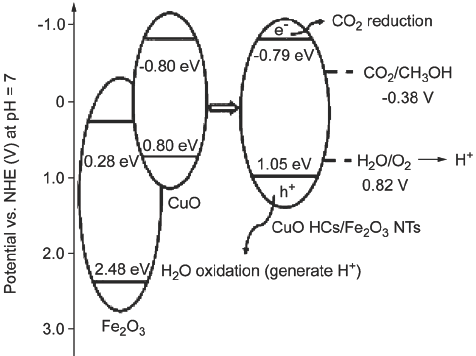| [1] Tao, Y. C.; Wu, S. H.; Zhang, X. Chemistry 2001, 64, 272. (陶映初, 吴少晖, 张曦, 化学通报, 2001, 64, 272.)[2] Guo, X. M.; Mao, D. S.; Lu, G. Z.; Wang, S. Acta Phys.-Chim. Sin. 2012, 28, 170. (郭晓明, 毛东森, 卢冠忠, 王嵩, 物理化学学报, 2012, 28, 170.)[3] Jin, Z. L.; Qian, L.; Lv, G. X. Prog. Chem. 2012, 22, 1102. (靳治良, 钱玲, 吕功煊, 化学进展, 2010, 22, 1102.)[4] Hu, Y. S.; Kleiman-Shwarsctein, A.; Forman, A. J.; Hazen, D.; Park, J. N.; McFarland, E. W. Chem. Mater. 2008, 20, 3803. [5] Cesar, I.; Kay, A.; Martinez, J. A. G.; Grätzel, M. J. Am. Chem. Soc. 2006, 128, 4582. [6] Zhong, D. K.; Sun, J. W.; Inumaru, H.; Gamelin, D. R. J. Am. Chem. Soc. 2009, 131, 6086. [7] Mao, A. M.; Shin, K.; Kim, J. K.; Wang, D. H.; Han, G. Y.; Park, J. H. ACS Appl. Mater. Interfaces 2011, 3, 1852. [8] Roy, S. C.; Varghese, O. K.; Paulose, M.; Grimes, C. A. ACS Nano 2010, 4, 1259. [9] Qin, S. Y.; Xin, F.; Liu, Y. D.; Yin, X. H.; Ma, W. J. Colloid Interface Sci. 2011, 356, 257. [10] Durand, W. J.; Peterson, A. A.; Studt, F.; Abild-Pedersen, F.; Nørskov, J. K. Surf. Sci. 2011, 605, 1354. [11] In, S. I.; Vaughn II, D. D.; Schaak, R. E. Angew. Chem. Int. Ed. 2012, 51, 3915. [12] Zhang, Z. H.; Hossain, M. F.; Takahashi, T. Appl. Catal. B-Environ. 2010, 95, 423. [13] Jia, Z. F.; Wang, F. M.; Bai, Y.; Liu, N. Adv. Mater. 2012, 396-398, 2033. [14] Mohapatra, S. K.; John, S. E.; Banerjee, S.; Misra, M. Chem. Mater. 2009, 21, 3048. [15] Cao, C. Y.; Qu, J.; Yan, W. S.; Zhu, J. F.; Wu, Z. Y.; Song, W. G. Langmuir 2012, 28, 4573. [16] Chaplin, R. P. S.; Wragg, A. A. J. Appl. Electrochem. 2003, 33, 1107. [17] Sun, Z. Y.; Yuan, H. Q.; Liu, Z. M.; Han, B. X.; Zhang, X. R. Adv. Mater. 2005, 17, 2993. [18] Shen, X. P.; Liu, H. J.; Pan, L.; Chen, K. M.; Hong, J. M.; Xu, Z. Chem. Lett. 2004, 33, 1128. [19] Nikolay, T.; Larina, L.; Shevaleevskiy, O.; Ahn, B. T. Energy Environ. Sci. 2011, 4, 1480. [20] Mohapatra, S. K.; Banerjee, S.; Misra, M. Nanotechnology 2008, 19, 1. [21] Zhang, L. N.; Wang, J. Y.; Zhang, H. X.; Cai, W. B. Acta Chim. Sinica 2010, 68, 590. (张莉娜, 王金意, 张涵轩, 蔡文斌, 化学学报, 2010, 68, 590.) |
